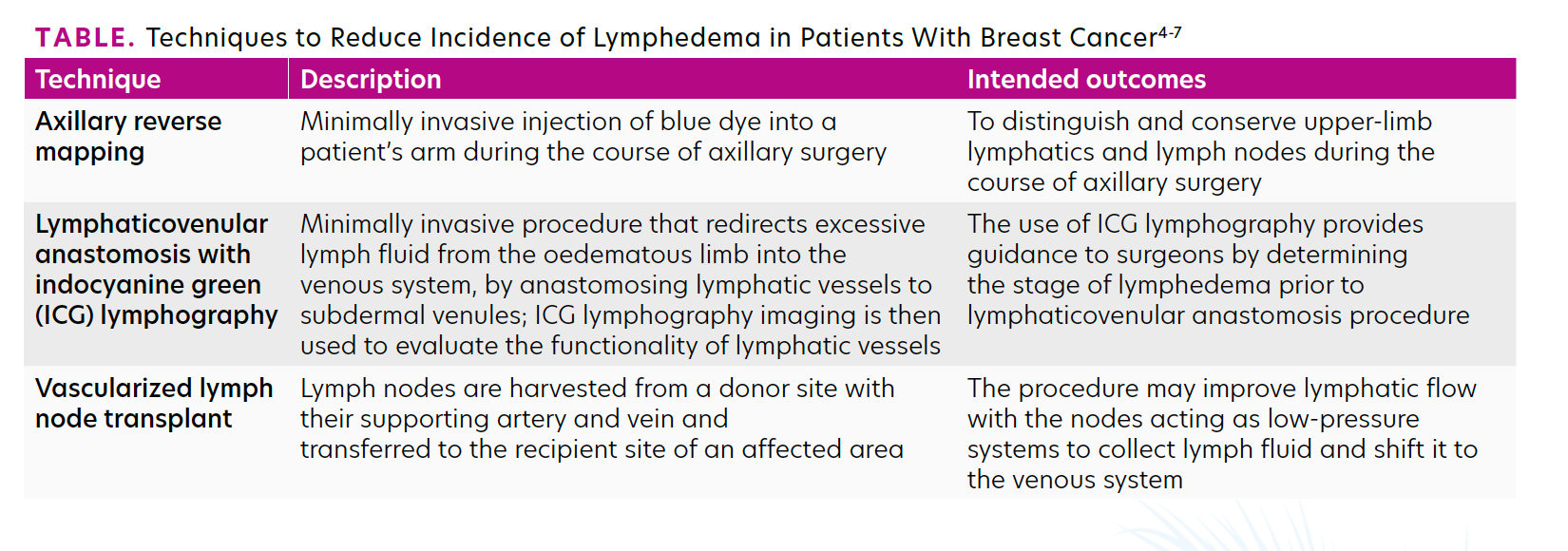Article
Surgical Considerations Emerge for Lymphedema Management
Author(s):
Promising techniques in surgical oncology are on the horizon for the treatment of lymphedema, an incurable adverse event that can often arise after certain types of breast cancer treatment.
Susan B. Kesmodel, MD

Promising techniques in surgical oncology are on the horizon for the treatment of
lymphedema, an incurable adverse event that can often arise after certain types of breast cancer treatment, according to Susan B. Kesmodel, MD.
“Anything that we can do as surgeons to primarily reduce lymphedema would be helpful for patients,” said Kesmodel, associate professor, director of Breast Surgical Oncology, and coleader of Breast Site Disease G at the Sylvester Comprehensive Cancer Center at the University of Miami Health System in Florida. “For patients who do develop lymphedema, if we can offer them both surgical and nonsurgical interventions, we can have a significant impact not only on their quality of life but [we] also could potentially reduce health care costs because the management of lymphedema can be very costly.”
In the past, lymphedema has primarily been treated with debulking procedures that remove the excess fluid through liposuction. These types of procedures typically provide only temporary improvement and do not address the condition physiologically. However, in recent years more physiologically impactful methods and considerations have been developed to curb the incidence and severity of lymphedema in patients with breast cancer.1
The Surgical Perspective
Patients who undergo axillary lymph node dissection are at an increased risk for developing lymphedema. Kesmodel said that reducing the extent and instance of axillary surgery, as long as it is oncologically safe, can have a major effect on lymphedema rates in patients with breast cancer.
“The extent of axillary surgery has a significant impact on the development of lymphedema,” Kesmodel explained. “It’s more common in those patients who undergo axillary lymph node dissection; most of the studies have demonstrated that the risk in that patient group is around 20%. With the addition of radiation therapy, this number can increase to as high as 30% to 35%.”
The use of axillary surgery has been reduced in recent years using procedures such as sentinel lymph node biopsy (SLNB). Results from an evaluation of 125 patients who underwent SNLB or axillary lymph node dissection for the staging of breast cancer showed that SLNB had a significant effect in preventing lymphedema. Specifically, lymphedema was observed in 2 of 77 patients (2.6%) who underwent SLNB compared with 13 of 48 patients (27%) who had an axillary lymph node dissection.2 Additionally, a systemic review of data from randomized controlled trials, which examined 5161 patients who had SLNB, small numbers of adverse events were reported following the procedure including lymphedema (range, 0%-11%), pain (11%-16%), sensory disorders (2%-22%), and motor disorders (0%-9%) at 6 months after surgery.3
New Techniques Reduce Adverse Outcomes
Axillary reverse mapping is another technique that may reduce the extent of lymphedema in patients who undergo axillary surgery. The minimally invasive technique uses dye injection to distinguish and conserve upper-limb lymphatics during axillary surgery. In a randomized, controlled trial of 48 patients who had axillary lymph node dissection, 24 patients in the study group were treated using axillary reverse mapping, and 24 patients in the control group underwent a conventional axillary lymph node dissection. At the 6-month follow-up, lymph node visualization was achieved in 20 patients (83.3%) in the study group. The incidence of lymphedema was 16.7% in the control group compared with 4.2% in the experimental group.4
Kesmodel said another option for managing lymphedema is lymphaticovenular anastomosis, also known as lymphovenous bypass. During this surgical procedure, a recipient vein is identified cutaneously and aided by lymphangiography, an anastomosis is created using microsurgical techniques. Several approaches can be utilized to perform the anastomosis, all requiring a microscope with high-magnification optics (TABLE4-7). The procedure requires time, meticulous technique, and experience.1
TABLE. Techniques to Reduce Incidence of Lymphedema in Patients With Breast Cancer

In a prospective evaluation of 100 patients with extremity lymphedema secondary to cancer treatment who underwent lymphovenous bypass, investigators observed symptom improvement in 96% of patients. A reduction in limb volume was seen in 74% of patients, with an average volume reduction of 42% at 12 months.5
Findings from another single-center prospective study of 100 patients with upper and lower extremity lymphedema showed that, after a mean follow-up of 25 months, decrease in upper and lower limb circumference was observed in 52.1% of patients with a mean decrease of 6%. Patients in this study also completed a quality-of-life assessment using the Lymphoedema Functioning, Disability, and Health Questionnaire (Lymph-ICF). Mean Lymph-ICF score significantly decreased from a preoperative 43.9 to 30.6 postoperative, representing a significant improvement in patient-reported quality of life.6
Of note, lymphaticovenular anastomosis comes with its own set of challenges. The procedure requires microvascular expertise and access to the necessary equipment, Kesmodel explained. There is also a concern for bleeding-related complications, although these have rarely been observed. In addition, allergic reactions may occur due to the use of isosulfan blue (Lymphazurin).
“If a more simplified lymphatic anastomosis approach is found to be effective, that is something that could potentially be used by a surgeon in any practice who doesn’t have access to advanced surgical techniques,” Kesmodel said. “A procedure like that could be more widely accepted and implemented across the United States and in countries around the world.”
Vascularized lymph node transplant (VLNT) to improve physiologic lymph clearance is a relatively new technique that presents another option for patients with lymphedema. Lymph nodes are harvested from a donor site with their supporting artery and vein and are then transferred to the recipient site of the affected area. Transplant nodes can be harvested from the groin, axilla, supraclavicular, submental, thoracic, and omental flaps.7
VLNT carries the risk of donor site morbidity. Surgeons also must consider the possibility of iatrogenic lymphedema and the location of the scar.
“Lymphedema has been a problem for a long time,” Kesmodel concluded. “It is less of a problem now because we’ve reduced axillary surgery, among other things, but I still believe it’s a significant quality-of-life issue for patients and we really need to do our best to minimize it.”
References
- Chang EI, Skoracki RJ, Chang DW. Lymphovenous anastomosis bypass surgery. Semin Plast Surg. 2018;32(1):22-27. doi:10.1055/s-0038-1636510
- Golshan M, Matin WJ, Dowlatshahi K. Sentinel lymph node biopsy lowers the rate of lymphedema when compared with standard axillary lymph node dissection. Am Surg. 2003;69(3):209-211; discussion 212.
- Pilger TL, Francisco DF, Candido Dos Reis FJ. Effect of sentinel lymph node biopsy on upper limb function in women with early breast cancer: a systematic review of clinical trials. Eur J Surg Oncol. Published online January 30, 2021. doi:10.1016/j.ejso.2021.01.024
- Faisal M, Sayed MG, Antonious K, Bakr AA, Farag SH. Prevention of lymphedema via axillary reverse mapping for arm lymph-node preservation following breast cancer surgery: a randomized controlled trial. Patient Saf Surg. 2019;13:35. doi:10.1186/s13037-019-0217-1
- Chang DW, Sumai H, Skoracki R. A prospective analysis of 100 consecutive lymphovenous bypass cases for treatment of extremity lymphedema. Plast Reconstr Surg. 2013;132(5):1305-1314. doi:10.1097/PRS.0b013e3182a4d626
- Qiu SS, Pruimboom T, Cornelissen AJM, et al. Outcomes following lymphaticovenous anastomosis (LVA) for 100 cases of lymphedema: results over 24-months follow-up. Breast Cancer Res Treat. 2020;184(1):173-183. doi:10.1007/s10549-020-05839-4
- Gould DJ, Mehrara BJ, Neligan P, Cheng MH, Patel KM. Lymph node transplantation for the treatment of lymphedema. J Surg Oncol. 2018;118(5):736-742. doi:10.1002/jso.25180









